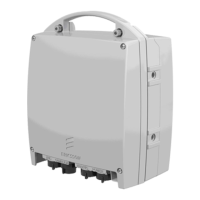MINI-LINK BAS 5-8
Technical Description EN/LZB 111 0542 P2B
5.2.2 Radio Link Adaptation
Radio link adaptation is needed to adapt data stream from base band to
the characteristics of the medium. The main processing is physical
parameter setting and frequency conversion.
A frequency conversion is then necessary in order to take the signal
from a fixed IF to the proper microwave frequency and viceversa, in
order to allocate the signal in the requested band.
On the modulation side, the input signal is filtered and up-converted to
350 MHz using a Voltage Control Oscillator (VCO) locked to the
reference oscillator.
The IF signal is then amplified and put towards the RAU interface.
The incoming signal from RAU towards the demodulator is at 140
MHz. It is amplified and demodulated down to base-band to extract its
in-phase and quadrature components.
It is possible to loop back the modulator output into the demodulator
input using a local shift oscillator that carries the 350 MHz signal
down-to 140 MHz.
Operation and administration signal needed to the RAU board
processor are sent via radio control interface by means of an
Amplitude Shift Keying (ASK) modulator at 6.5 MHz. Data provided
by RAU processor to modem is decoded by a ASK demodulator
working at 4.5 MHz.
5.2.3 Modulation
The adopted modulation technique is called Constant envelope
Quaternary Phase Shift Keying (C-QPSK).
In the C-QPSK modulation the complex envelope is always on the
Unit circle and its average position in the decision instants is centred
in one of the eight points.
The C-QPSK modulated signal is generated by setting the control
voltage of a VCO, according to the bits stream to be modulated.
The bits stream at the modulator input generates a voltage level, which
depends on the value of the modulation index, mod_index_Tx.
The modulation index signal in the transmission, mod_index_Tx, is
extracted by the remote demodulator and feedback to the modulator
by Mod Index radio control loop.

